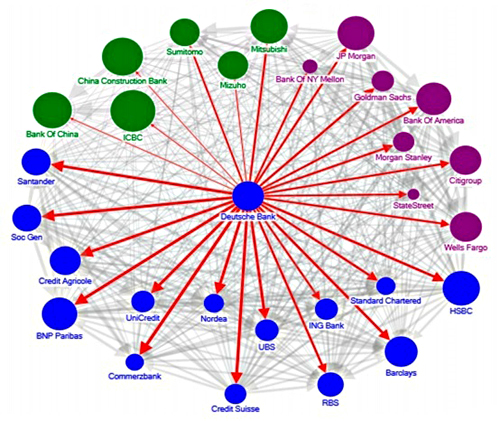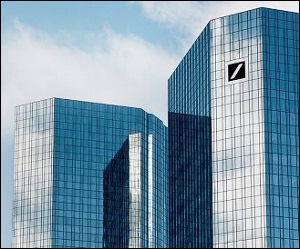By Pam Martens and Russ Martens: September 30, 2019 ~
Last week, as the Fed was carrying out hundreds of billions of dollars in emergency loan operations on Wall Street for the second week in a row – the first such operations since the financial crisis – Deutsche Bank’s headquarters office in Frankfurt, Germany was being raided by police for the second time in less than a year. That’s not the sort of thing that inspires confidence among depositors to keep their money in your bank.
Deutsche Bank has been a constant headache for the U.S. financial system because it is heavily intertwined via derivatives with the big banks on Wall Street, including JPMorgan Chase, Citigroup, Goldman Sachs, Morgan Stanley and Bank of America. It has become the dark cloud on the horizon in the same way Citigroup cast a negative pall in the early days of the financial crisis of 2008. (It’s not a good omen that Citigroup’s stock eventually went to 99 cents and the bank received the largest taxpayer and Federal Reserve bailout in U.S. history. The Fed alone secretly pumped $2.5 trillion in revolving loans into Citigroup from December 2007 to the middle of 2010.)
The latest raid at Deutsche Bank occurred on Tuesday and Wednesday of last week, September 24 and 25, and was related to the $220 billion money laundering probe of Danske Bank, Denmark’s largest lender. Deutsche Bank served as correspondent bank to Danske’s Estonia branch where the laundering is alleged to have occurred. On Wednesday, as the raid was proceeding, the body of Aivar Rehe who previously ran the Estonia business of Danske Bank, was discovered by police in Estonia. Rehe had been questioned by prosecutors and was considered a key witness in the probe. His death is being called an apparent suicide by European media.
On the day the police raid started at Deutsche Bank, Tuesday, September 24, the Federal Reserve Bank of New York offered $30 billion in 14-day emergency term loans and had demand for more than twice that amount. That led the New York Fed to increase its subsequent 14-day term loans from $30 billion to $60 billion later in the week. The Fed’s overnight repo loans that were offered every day last week were also increased from $75 billion per day to $100 billion per day.
As the timeline below illustrates, Deutsche Bank has been in a slow motion collapse as a result of its serial crime charges while international regulators have failed to address the fact that it is a counterparty to $49 trillion notional (face amount) in derivatives according to its 2018 annual report and thus presents systemic risk throughout the global financial system.
Wall Street On Parade believes that the repo crisis on Wall Street may, at least in part, relate to big Wall Street banks backing away from lending to Deutsche Bank. You can read the timeline below and make up your own mind.
~~~
January 26, 2014: William Broeksmit, 58, was found hanged in his London home. Police ruled the death “non-suspicious.” Broeksmit was a senior executive at Deutsche Bank involved in assessing risk on the bank’s balance sheet. (See Documents Emerge in Senate Hearing from William Broeksmit, Deutsche Exec Alleged to Have Hanged Himself in January.) The death occurred on Sunday. Deutsche Bank’s stock closed the next business day at $49.94 in New York.
October 20, 2014: The body of Calogero Gambino, 41, was found by his wife hanging from a stairway banister in their Manhattan home. Gambino was a lawyer for Deutsche Bank who had been cooperating with U.S. regulators on Deutsche Bank’s involvement in the rigging of the interest rate benchmark, Libor. The stock closed at $31.09 in New York.
April 23, 2015: Deutsche Bank pleads guilty to the U.S. Department of Justice for its role in rigging the benchmark interest rate known as Libor. It pays fines of $2.519 billion to various regulators. Deutsche Bank’s stock closes at $34.15 in New York.
June 2016: The International Monetary Fund (IMF) releases a report that finds that Deutsche Bank poses the greatest threat to global financial stability than any other bank because of its interconnections to Wall Street mega banks and large banks in Europe. (See graph below.)
January 17, 2017: Deutsche Bank reaches a settlement with the U.S. Department of Justice in which it agrees to pay $7.2 billion in fines and restitution for its improper “packaging, securitization, marketing, sale and issuance of residential mortgage-backed securities (RMBS) between 2006 and 2007.” Deutsche Bank stock closes at $18.56 in New York.
January 30, 2017: Deutsche Bank was fined a total of $630 million by U.S. and U.K. regulators over claims it had laundered upwards of $10 billion on behalf of Russian investors. Deutsche Bank’s stock closes at $20.11 in New York.
November 29, 2018: Deutsche Bank’s headquarters in Germany were raided by 170 members of law enforcement. Prosecutors said at the time that “Deutsche Bank helped customers found offshore organizations in tax havens by transferring illegally acquired money without alerting authorities to suspected money laundering.” Deutsche Bank’s stock closes at $9.42 in New York.
April 25, 2019: Merger talks end between Commerzbank and Deutsche Bank. Wall Street On Parade headlines our story: Deutsche Bank Merger Talk Ends – Now Comes the Pain. Deutsche Bank’s stock closes at $8.35 in New York.
May 19, 2019: The New York Times’ David Enrich writes the bombshell report describing how a Deutsche Bank whistleblower, Tammy McFadden, and four of her colleagues, had their efforts blocked by the bank when they tried to file suspicious activity reports on bank accounts affiliated with Donald Trump and his son-in-law/advisor Jared Kushner. The suspicious activity reports (SARs) should have been filed with the Federal agency known as FinCEN (Financial Crimes Enforcement Network) but were quashed by a unit of the bank that manages money for the super wealthy. The article appeared in the print edition of the New York Times on Monday, May 20, 2019. The stock closes that day at $7.43.
July 7, 2019: Deutsche Bank confirms plans to fire 18,000 workers and reorganize into a good bank/bad bank. The bad bank will hold assets it plans to sell. (This is what Citigroup did during the financial crisis.) Deutsche Bank stock closes on Monday, July 8, at $7.54.
September 24, 2019: German police raid Deutsche Bank headquarters for the second time in less than a year. Deutsche Bank stock closes at $7.58 in New York. (Deutsche Bank’s stock had traded for $120 a share in 2007.)
This past Friday, Deutsche Bank closed at $7.56 in New York trading. It had a common stock market capitalization of $15.63 billion with a derivatives book of $49 trillion. Its similarities to Citigroup in 2008 are mind-numbing given a decade of political talk about how risk has been reined in on Wall Street.

Systemic Risk Among Deutsche Bank and Global Systemically Important Banks (Source: IMF — “The blue, purple and green nodes denote European, US and Asian banks, respectively. The thickness of the arrows capture total linkages (both inward and outward), and the arrow captures the direction of net spillover. The size of the nodes reflects asset size.”)
Related Articles:
The Fed and Wall Street Have their Worry Beads Out Over Deutsche Bank’s “Bad Bank” Idea
After a $354 Billion U.S. Bailout, Germany’s Deutsche Bank Still Has $49 Trillion in Derivatives


